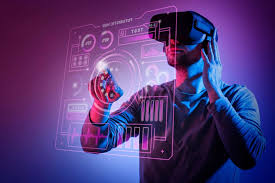Artificial intelligence is changing the world faster than ever before, and the field of graphic design is no exception. What was once entirely dependent on manual creativity and technical skill is now being transformed by intelligent tools and automated processes. Designers today are not just artists—they are collaborators with powerful technology that expands their creative possibilities. The future of graphic design is deeply intertwined with AI trends and innovation, making design more efficient, personalized, and impactful than ever before.
Graphic design has always been about communicating ideas visually. Whether it’s a logo, website layout, advertisement, or product packaging, design shapes how people see and connect with the world around them. But as technology evolves, the way we design is also evolving. AI is becoming an essential part of the creative process, enabling designers to work faster, explore more ideas, and push the limits of their imagination. Instead of replacing designers, AI is becoming a powerful partner, taking care of repetitive tasks and opening new creative doors.
One of the biggest changes AI brings to graphic design is automation. Simple tasks that once took hours can now be done in seconds. For example, removing image backgrounds, resizing elements, generating layouts, or matching colors can all be automated with smart tools. Designers can focus their energy on creativity and strategy instead of technical adjustments. This shift is allowing even beginners to create professional-quality designs with less effort, while experienced designers can deliver more work in less time.
Another important trend is personalization. AI can analyze data and user behavior to help designers create designs tailored to specific audiences. Instead of a one-size-fits-all approach, brands can now deliver visuals that match individual preferences, locations, and habits. This level of personalization is making design more powerful and effective, especially in marketing and advertising. A campaign can adapt in real time, changing visuals to match different user segments automatically.
AI also helps generate creative ideas. In the past, designers would spend hours brainstorming concepts or sketching variations. Now, AI-powered platforms can suggest color palettes, layouts, and font pairings based on trends and audience insights. Designers can explore multiple directions instantly, selecting the one that fits best. This doesn’t replace creativity—it enhances it, giving designers more inspiration and faster ways to bring ideas to life.
Tools powered by AI are also improving accessibility in design. People who may not have professional design skills can use intelligent platforms to create beautiful graphics with just a few clicks. This is expanding the creative world, allowing small businesses, freelancers, and students to participate in professional-level design work. The future of design is not limited to experts—it is becoming more inclusive, empowering more people to express their ideas visually.
The rise of AI also means design trends are evolving at a faster pace. What used to take months to develop can now happen in weeks. Designs are becoming more dynamic, adaptive, and intelligent. For example, AI can analyze current design trends, social media engagement, and market performance to suggest styles that are more likely to succeed. This means designers are working with data-driven insights, creating work that not only looks good but also performs well in real-world applications.
Another key innovation is generative design. With the help of AI, designers can input certain parameters—like color preferences, target audience, or mood—and let the system create multiple versions of a design. This process saves time and reveals unexpected creative directions. Generative design also allows for endless experimentation, making it easier to find unique solutions that stand out in a competitive market.
AI is also transforming how designers collaborate. Instead of working in isolation, teams can use intelligent platforms that streamline communication, feedback, and revisions. Real-time AI assistance can suggest improvements, correct errors, and optimize layouts automatically. This creates a smoother workflow and faster delivery, which is especially valuable in industries like marketing, entertainment, and technology.
One of the most exciting areas where AI is influencing graphic design is branding. A brand’s visual identity is one of its most powerful assets, and AI is helping companies refine and protect that identity across platforms. AI can ensure consistency in fonts, colors, and layouts while allowing for personalized variations when needed. This creates a stronger, more unified brand presence while maintaining flexibility.
As AI continues to evolve, designers are learning to adapt. Some worry that automation might reduce the value of human creativity, but the reality is different. AI can create designs based on rules and data, but it lacks human emotion, cultural understanding, and storytelling ability. These are qualities only humans can bring to the table. The best designers of the future will be those who can combine human creativity with AI’s speed and intelligence, creating work that is both efficient and deeply meaningful.
Ethics and responsibility are becoming important topics as well. As AI grows more powerful, designers must be careful about how they use it. Issues like originality, copyright, and data privacy are crucial to address. Designers need to ensure that their use of AI respects creative integrity and human values. The future of design isn’t just about technology; it’s about using technology wisely.
AI is also creating new design roles and skills. Traditional graphic design is expanding to include areas like AI-assisted illustration, automated branding, and data-driven design strategy. Designers who learn how to work with AI tools will have a major advantage in the creative industry. Instead of fearing AI, learning to master it will open doors to exciting opportunities and innovative careers.
Visual content is more important than ever in the digital world, and the demand for designers continues to grow. AI is not replacing this demand; it’s amplifying it. Businesses want smart, fast, and high-quality design, and AI makes that possible. But they still need human designers to bring emotion, storytelling, and strategy into the work. AI and human creativity together can produce results far greater than either could alone.
The future of design will be more interactive, immersive, and intelligent. Designers will use AI to create personalized experiences, dynamic visuals, and adaptable content. Imagine a website that changes its color palette based on the viewer’s mood or a logo that evolves in real time. These kinds of experiences are already becoming possible, and they will define the next generation of design.
In this new era, continuous learning will be essential. Designers who stay updated with the latest AI trends and tools will be at the forefront of the industry. They will not only create beautiful visuals but also shape how people interact with technology and brands. Those who resist change may find it harder to keep up, but those who embrace it will have limitless possibilities.
Ultimately, AI is not here to take creativity away—it’s here to enhance it. It is giving designers new ways to express their ideas, save time, and make a bigger impact. The future of graphic design belongs to those who can balance creativity and innovation, blending artistic vision with technological power.
As the design world continues to evolve, one thing remains constant: human creativity is at the heart of it all. AI may provide the tools, but designers provide the soul. This partnership between human and machine will shape the future of visual communication, making it smarter, faster, and more inspiring than ever before. The next generation of designers will not just use AI—they will collaborate with it to build a more creative, connected world.




